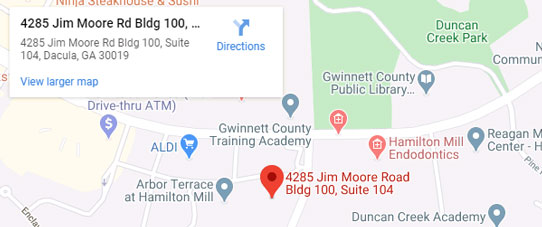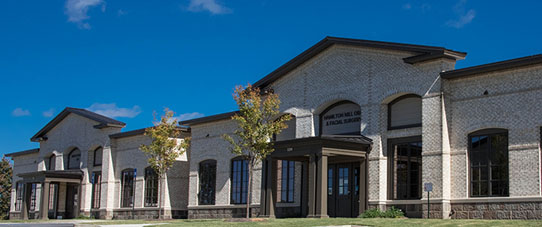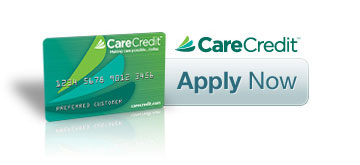Impacted Canines
An impacted tooth simply means that it is "stuck" and can not erupt into function. Patients frequently develop problems with impacted third molar (wisdom) teeth. These teeth get "stuck" in the back of the jaw and can develop painful infections among a host of other problems (see Impacted wisdom teeth). Since there is rarely a functional need for wisdom teeth, they are usually extracted if they develop problems. The maxillary cuspid (upper eye tooth) is the second most common tooth to become impacted. The cuspid tooth is a critical tooth in the dental arch and plays an important role in your "bite". The cuspid teeth are very strong biting teeth which have the longest roots of any human teeth. They are designed to be the first teeth that touch when your jaws close together so they guide the rest of the teeth into the proper bite.
Normally, the maxillary cuspid teeth are the last of the "front" teeth to erupt into place. They usually come into place around age 13 and cause any space left between the upper front teeth to close tight together. If a cuspid tooth gets impacted, every effort is made to get it to erupt into its proper position in the dental arch. The techniques involved to aid eruption can be applied to any impacted tooth in the upper or lower jaw, but most commonly they are applied to the maxillary cuspid (upper eye) teeth. 60% of these impacted eye teeth are located on the palatal (roof of the mouth) side of the dental arch. The remaining impacted eye teeth are found in the middle of the supporting bone but stuck in an elevated position above the roots of the adjacent teeth or on the lip side of the dental arch.
Early recognition of impacted eye teeth is the key to successful treatment:
The older the patient, the more likely an impacted eye tooth will not erupt by nature’s forces alone even if the space is available for the tooth to fit in the dental arch. The American Association of Orthodontists recommends that a panorex screening x-ray along with a dental examination be performed on all dental patients at around the age of 7 years to count the teeth and determine if there are problems with eruption of the adult teeth. It is important to determine whether all the adult teeth are present or are some adult teeth missing. Are there extra teeth present or unusual growths that are blocking the eruption of the eye tooth? Is there extreme crowding or too little space available causing an eruption problem with the eye tooth? This exam is usually performed by your general dentist or hygienist who will refer you to an orthodontist if a problem is identified. Treating such a problem may involve an orthodontist placing braces to open spaces to allow for proper eruption of the adult teeth. Treatment may also require a referral to an oral surgeon for extraction of over retained baby teeth and/or selected adult teeth that are blocking the eruption of the all important eye teeth. The oral surgeon will also need to remove any extra teeth (supernumerary teeth) or growths that are blocking eruption of any of the adult teeth. If the eruption path is cleared and the space is opened up by age 11 or 12, there is a good chance the impacted eye tooth will erupt with nature’s help alone. If the eye tooth is allowed to develop too much (age 13-14), the impacted eye tooth will not erupt by itself even with the space cleared for its eruption. If the patient is too old (over 40), there is a much higher chance the tooth will be fused in position. In these cases the tooth will not budge despite all the efforts of the orthodontist and oral surgeon to erupt it into place. Sadly, the only option at this point is to extract the impacted tooth and consider an alternate treatment to replace it in the dental arch (crown on a dental implant or a fixed bridge).
What happens if the eye tooth will not erupt when proper space is available?
In cases where the eye teeth will not erupt spontaneously, the orthodontist and oral surgeon work together to get these unerupted eye teeth to erupt. Each case must be evaluated on an individual basis but treatment will usually involve a combined effort between the orthodontist and the oral surgeon. The most common scenario will call for the orthodontist to place braces on the teeth (at least the upper arch). A space will be opened to provide room for the impacted tooth to be moved into its proper position in the dental arch. If the baby eye tooth has not fallen out already, it is usually left in place until the space for the adult eye tooth is ready. Once the space is ready, the orthodontist will refer the patient to the oral surgeon to have the impacted eye tooth exposed and bracketed.
In a simple surgical procedure performed in the surgeon’s office, the gum on top of the impacted tooth will be lifted up to expose the hidden tooth underneath. If there is a baby tooth present, it will be removed at the same time. Once the tooth is exposed, the oral surgeon will bond an orthodontic bracket to the exposed tooth. The bracket will have a miniature gold chain attached to it. The oral surgeon will guide the chain back to the orthodontic arch wire where it will be temporarily attached. Sometimes the surgeon will leave the exposed impacted tooth completely uncovered by suturing the gum up high above the tooth or making a window in the gum covering the tooth (on selected cases located on the roof of the mouth). Most of the time, the gum will be returned to its original location and sutured back with only the chain remaining visible as it exits a small hole in the gum. Recently, specialized orthodontic mini-implants known as TADS have been used in some cases to aid in eruption of the impacted tooth. Dr. Cardona-Rohena will discuss the need for this option.
Shortly after surgery (1-14 days) the patient will return to the orthodontist. A rubber band will be attached to the chain to put a light eruptive pulling force on the impacted tooth. This will begin the process of moving the tooth into its proper place in the dental arch. This is a carefully controlled, slow process that may take up to a full year to complete. Once the tooth is moved into the arch in its final position, the gum around it will be evaluated to make sure it is sufficiently strong and healthy to last for a lifetime of chewing and tooth brushing. In some circumstances, especially those where the tooth had to be moved a long distance, there may be some minor "gum surgery" required to add bulk to the gum tissue over the relocated tooth so it remains healthy during normal function. Your dentist or orthodontist will explain this situation to you if it applies to your specific situation.
The surgery to expose and bracket an impacted tooth is a very straight forward surgical procedure that is performed in the oral surgeon’s office. It is performed using either local anesthesia, or sedation. The procedure is generally scheduled for 45 minutes if one tooth is being exposed and bracketed and 75 minutes if both sides require treatment. If the procedure only requires exposing the tooth with no bracketing, the time required will be shortened by about one half. These issues will be discussed in detail at your preoperative consultation with your doctor.
Recent studies have revealed that with early identification of impacted eye teeth (or any other impacted tooth other than wisdom teeth), treatment should be initiated at a younger age. Once the general dentist or hygienist identifies a potential eruption problem, the patient should be referred to the orthodontist for early evaluation. In some cases the patient will be sent to the oral surgeon before braces are even applied to the teeth. As mentioned earlier, the surgeon will be asked to remove over retained baby teeth and/or selected adult teeth. He will also remove any extra teeth or growths that are blocking eruption of the developing adult teeth. Finally, he may be asked to simply expose an impacted eye tooth without attaching a bracket and chain to it. In reality, this is an easier surgical procedure to perform than having to expose and bracket the impacted tooth. This will encourage some eruption to occur before the tooth becomes totally impacted (stuck). By the time the patient is at the proper age for the orthodontist to apply braces to the dental arch, the eye tooth will have erupted enough that the orthodontist can bond a bracket to it and move it into place without needing to force its eruption. In the long run, this saves time for the patient and means less time in braces (always a plus for any patient!).
What to expect from surgery to expose and bracket an impacted tooth:
The surgery to expose and bracket an impacted tooth is a very straight forward surgical procedure that is performed in the oral surgeon’s office. For most patients, it is performed with using laughing gas and local anesthesia. In selected cases it will be performed under I.V. sedation if the patient desires to be asleep, but this is generally not necessary for this procedure. The procedure is generally scheduled for 45 minutes if one tooth is being exposed and bracketed and 75 minutes if both sides require treatment. If the procedure only requires exposing the tooth with no bracketing, the time required will be shortened by about one half. These issues will be discussed in detail at your preoperative consultation with your doctor.
You can expect a limited amount of bleeding from the surgical sites after surgery. Although there will be some discomfort after surgery at the surgical sites, most patients find Tylenol or Advil to be more than adequate to manage any pain they may have. Within 2-3 days after surgery there is usually little need for any medication at all. There may be some swelling from holding the lip up to visualize the surgical site; it can be minimized by applying ice packs to the lip for the afternoon after surgery. Bruising is not a common finding after these cases. A soft, bland diet is recommended at first, but you may resume your normal diet as soon as you feel comfortable chewing. It is advised that you avoid sharp food items like crackers and chips as they will irritate the surgical site if they jab the area during initial healing. Sometimes a post operative visit is scheduled depending on the actual surgery that is performed. This will be discussed with your and your family on the day of surgery. Most orthodontists will see their patients within 10-14 days following surgery to activate the eruption process by applying the proper rubber band to the chain on your tooth. Please check with your orthodontist with respect to when they want to see you. As always Dr. Cardona-Rohena is available at the office or can be reached after hours if any problems should arise after surgery. Simply call our office at 678-835-1135 if you have any questions.









